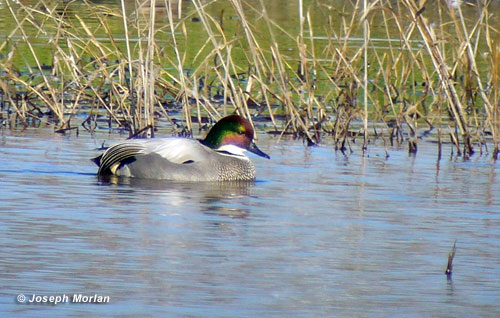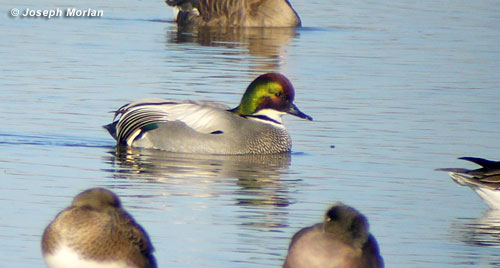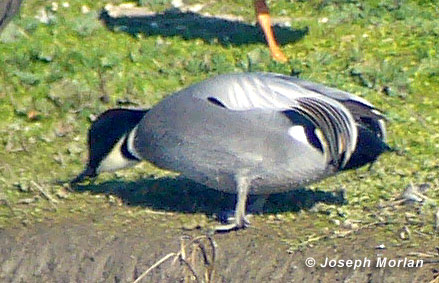Falcated Duck (Anas falcata)
Colusa National Wildlife Refuge, Colusa, Colusa County, CA
20 December 2011
Joseph Morlan
Photos © 20 December by Joseph Morlan. All rights reserved.
 Robbie Fischer and I decided to head up to Colusa this morning to see
the Falcated Duck which had been present since 8 December 2011 when found at the refuge viewing platform by Dan
Tankersley and Gary Fregien. It has been seen almost every day since then with the notable exception of Saturday
10 December when it was searched for all day but missed. We encountered dense tule fog on the trip up in the
morning, but it had lifted by the time we arrived at the refuge around 10am. A group of birders including Lisa
Hug, Ruth Rudesill, Mike Parmeter and Ted Eliot, had it located between the two islands. Jeff Hoppes arrived later
and photographed the bird (link below). Light was favorable and I attempted to digiscope the bird with the result
seen here. I have posted a higher resolution image here.
Robbie Fischer and I decided to head up to Colusa this morning to see
the Falcated Duck which had been present since 8 December 2011 when found at the refuge viewing platform by Dan
Tankersley and Gary Fregien. It has been seen almost every day since then with the notable exception of Saturday
10 December when it was searched for all day but missed. We encountered dense tule fog on the trip up in the
morning, but it had lifted by the time we arrived at the refuge around 10am. A group of birders including Lisa
Hug, Ruth Rudesill, Mike Parmeter and Ted Eliot, had it located between the two islands. Jeff Hoppes arrived later
and photographed the bird (link below). Light was favorable and I attempted to digiscope the bird with the result
seen here. I have posted a higher resolution image here.
The bird spent most of its time dabbling in the shallow water with its head under the water. It flew one time
and landed on the far side of the left island. One time it swam to the berm on the east side of the impoundment
and walked around a bit before coming back into the water to continue feeding.
We then drove the auto tour loop road and checked the bird again on the way out about 12:30pm.
Description
The following description is based on memory and on photos:
A medium-sized duck about the same size as the Northern Pintails and American Wigeons in direct comparison.
It was very distinctly marked with a mix of iridescent green and purple on its head. Depending on the light, the
purple often showed as a copper color. The bill was quite long, slender and rather attenuated at the tip. A distinct
white spot was evident on the forehead and there was a pale gray area on the side of the bill near the base, recalling
the pattern on a Northern Pintail. The chin and throat were white with a narrow black neck ring extending across
the top of the chest and separated from the rest of the mottled chest by a narrow white band. The rear of the head
formed a narrow pointed crest with a green tip. The shape of the wispy crest reminded us of Hooded Merganser.
The body was gray, with fine herring-bone vermiculations along the sides and flanks, but with a coarse pattern
of black and white mottling on the chest. The chest pattern was thus similar to Gadwall, but the body pattern,
including the black lesser wing coverts recalled the pattern of Northern Pintail. The flanks were pale yellow,
outlined in black, again similar to pintail. The speculum appeared dark most of the time, but shone deep green
in good light. There was no obvious border to the speculum.
Most spectacular were the strongly elongated sickle-shaped scapulars which hung over the tail often with
their tips touching the water. These feathers were black with frosty gray fringes. The mantle feathers were pale
gray with frosty fringes. The tail appeared black and there was pale gray mottling on the rump.
The legs were dull gray. I was able to see the feet and there appeared to be no obvious abnormality, nor
did the bird limp in any way when it walked on the ground. The bird was reported to have both rear toes intact
and my photo (below right) shows them.
Discussion
This bird was first discovered 8 December by Dan Tankersley and Gary Fregien, and it has been seen by numerous
observers and well photographed. Here are some outside links to additional photos:
|
|


Media Reports
|
This species was formerly called "Falcated Teal." In 1997 the name was changed in the 41st
supplement to the AOU Check-List to Falcated Duck. I have seen this species once before in California, a male
in March 2002 at Honey Lake. Details on that bird with discussion of natural occurrence issues are here.
Falcated Duck pairs are available for sale for $350 here.
I checked the International Species
Information System and found no Falcated Ducks currently listed in captivity in the major zoos which are members
of this inventory.
Update - 29 December 2011
Flight shots obtained by Marilyn Kircus on 24 December appear to show some defects in the webbing of the left
foot. There appears to be a small hole in the web and the tip of the web may be torn. However, these defects are
not evident in photos by Vic Murayama taken 3 days earlier.
9 January 2011
An undated photo by Michael Peters published by the AP appears to show the left toe on the left foot is bent
up and down at the joint.
 Robbie Fischer and I decided to head up to Colusa this morning to see
the Falcated Duck which had been present since 8 December 2011 when found at the refuge viewing platform by Dan
Tankersley and Gary Fregien. It has been seen almost every day since then with the notable exception of Saturday
10 December when it was searched for all day but missed. We encountered dense tule fog on the trip up in the
morning, but it had lifted by the time we arrived at the refuge around 10am. A group of birders including Lisa
Hug, Ruth Rudesill, Mike Parmeter and Ted Eliot, had it located between the two islands. Jeff Hoppes arrived later
and photographed the bird (link below). Light was favorable and I attempted to digiscope the bird with the result
seen here. I have posted a higher resolution image here.
Robbie Fischer and I decided to head up to Colusa this morning to see
the Falcated Duck which had been present since 8 December 2011 when found at the refuge viewing platform by Dan
Tankersley and Gary Fregien. It has been seen almost every day since then with the notable exception of Saturday
10 December when it was searched for all day but missed. We encountered dense tule fog on the trip up in the
morning, but it had lifted by the time we arrived at the refuge around 10am. A group of birders including Lisa
Hug, Ruth Rudesill, Mike Parmeter and Ted Eliot, had it located between the two islands. Jeff Hoppes arrived later
and photographed the bird (link below). Light was favorable and I attempted to digiscope the bird with the result
seen here. I have posted a higher resolution image here.
